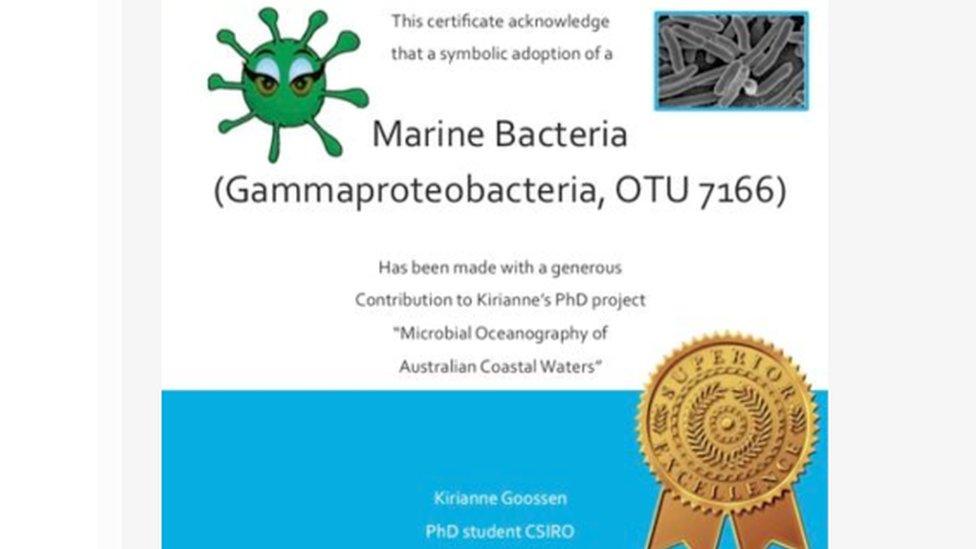The entrepreneurial new breed of Australian scientists
- Published

A seal fitted with a tracking device, or geolocator
Young Australian scientists desperate for research funding are finding inventive ways to pay for their projects, as Paul Carter reports from Hobart.
Somewhere in the vast Southern Ocean, what could be next year's ideal Christmas gift is travelling about attached to an albatross or seal.
It's a 2g (0.07oz) animal tracking device, or geolocator, which will be turned into a piece of jewellery by young Australian scientists in their spare time.
The scientists retrieve the tracker when the animal, following a seasonal pattern, returns to its burrow or beach.
By fixing it to recycled metal from Antarctica, the tracker is turned into a brooch shaped like the animal it was tagged to.
The jewellery sells for a minimum A$100 (£59; $72) donation, allowing the scientists to buy more trackers to further study the habits of sea birds and seals.
Funding challenge
PhD candidate Jaimie Cleeland said making the jewellery helped cover the significant cost of travelling to locations in Antarctica and the Southern Ocean to continue her research.
Accessing those areas consumed much of her grant money, and she wanted another way to progress her academic career.
"The extra money allows us to do that extra bit of science and make the most of it when we are in these extreme environments," Ms Cleeland said.

A geolocator brooch cut to look like a seal
"It's not something that will ever be able to support a whole research project entirely, but it will be something that allows an honours student or PhD student to do a project or a paper."
A new geolocator costs A$200. This year Ms Cleeland and her collaborator, fine art PhD candidate Annalise Rees, sold enough brooches to buy 100 geolocators.
The pair have also been in talks to receive spent geolocators from the British Antarctic Survey and the French Polar Institute.
Adopt a bacteria colony
Funding research in Australia remains a continuing challenge. Earlier this year, Australia's science agency cut 275 jobs in a move that attracted controversy, external.
But creative fundraising is providing opportunities for other scientists.
PhD candidate Kirianne Goossen used crowdfunding to invite people to make a "symbolic adoption" of a marine bacteria colony.
For A$10, supporters of Ms Goossen's research into the biodiversity of real marine microbes could "adopt" one in virtual form. The supporters received an online certificate with information about their bacterium.

A 'certificate of adoption' for a marine bacteria colony
Ms Goossen used the campaign to raise the A$1500 she needed to travel to Europe so she could present her PhD at a conference. The University of Tasmania also provided A$2000 through a funding application.
Her supervisor, Associate Professor John Bowman, said it was very hard to find the funding to enable such travel.
"People have to be creative in the way they approach these things," he said.
"The money can either come out of the student's pocket or they can do what Kirianne did, which was bold, and try to crowdfund it."
'Drop in the ocean'
Prof Bowman said crowdfunding by young scientists was useful to "fill the gaps" for early career development.
But it would face legal hurdles if it were ever used for core research, where commercial issues arise about who owns the intellectual property.
"Crowdfunding of science is always going to be a drop in the ocean anyway. A few thousand dollars here and there is nothing compared to research projects worth several million dollars," he said.
"For the next few years anyway it will only be for entrepreneurial scientists - clever, creative types seeking to fill gaps due to tight funding."
Prof Bowman said expectations placed on researchers seemed to be increasing: they had to do more, provide more samples, track more animals.

Annalise Rees (left) and Jaimie Cleeland wear their brooches
For Ms Cleeland and her peers, creative funding enterprises mark a departure in practice from their mentors.
"They definitely weren't doing it as much as we are now," she said.
"Maybe that's not a sign of the times, but more a sign of how you progress your academic career now. Crowdfunding is definitely seen more and more now for scientific research."
She and Ms Rees will move on next year after completing their PhDs. But they hope their replacements will take over their website, external and continue making jewellery to fund research.